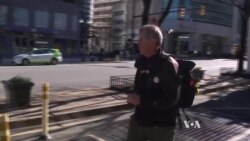In the wake of an international agreement to slow the impact of climate change, a lot of people are thinking about things they can do on a personal level that might make a difference. One of the easiest ways to have a big impact: get out of your car.
Hanging up the keys to walk, bike, run, jog, or shuffle your way around town is such a convincingly win-win proposition — lower your carbon footprint while getting some exercise! — it's an increasingly common element of urban and suburban living. Indeed, residents of some U.S. cities have begun demanding more car-less municipal amenities, and city administrators are listening.
Urban planners, too, are re-thinking city designs to make them more "walkable," with easy and safe access to shopping, dining and public transportation.
Their work is paying off, as thousands of cities adopt new policies to benefit pedestrians and cyclists. The Redfin Real Estate Company looked at 2,500 mid-size communities to identify the most walkable of 2015. Alina Ptaszynski, Redfin’s spokesperson, explained the study mapped out all the locations that could be walk to in a given neighborhood or a city, and gave them a score. "It factors in data about pedestrian friendliness, things like density in the area, length of the blocks, the width of the road. So it factors all these things in and crunches the numbers. It gives you a score between zero and 100.”
Jersey City, in New Jersey, got the top score of 84, followed by Newark, New Jersey. Coming in third, with a score of 67, was Arlington, Virginia, a suburb of the nation's capital, which one of the most congested metropolitan areas in the U.S.
Walking the walk
Henry Dunbar has been at the forefront of Arlington's transformation. As manager of the Bike Arlington and Walk Arlington programs, he is living the lifestyle he’s promoting. He has a car, but only uses it occasionally, “primarily just on weekends.” He has been biking to work since 2009.
He points to a number of approaches to promoting biking and walking. “It’s through what we call the five Es, which are engineering, education, enforcement, encouragement and evaluation. We let people know about the various ways they can get around without using their cars. We also have many publications electronic and paper that we put out. We do maps showing people the easiest ways to get around both on foot or on bike.”
Getting around on foot or by bike is recommended for better health and a cleaner environment. "It can get them to places oftentimes cheaper and much faster than taking their cars,” Dunbar points out.
Live, work, play
Real estate agent Ed Schmidt has been living and working in Arlington for over 20 years. He understands why people want to move there.
“More and more people want the ability to take Metro to their job or walk to their job from their apartment or their houses," he said. "They are young people who really like the proximity to shops and restaurants and bars and clubs, but there is also a lot of older people who choose to downsize from some of the older houses in Arlington that they lived in for 30 years. They can get to the metro; they don't have to drive. They can shop anytime as the grocery stores are right under their building.”
Walk Arlington and Bike Arlington programs manager Dunbar says that as more people choose a car-free life style, this trend will likely continue and grow.
“Communities today are being designed so that people can live, work and play in the same place," he said. "We really need to work with our community planners and politicians to make sure that they know how much we value that. We really have to look long term and design our streets and communities in ways that [make it] easy for people to adopt these life styles if they want to.”











